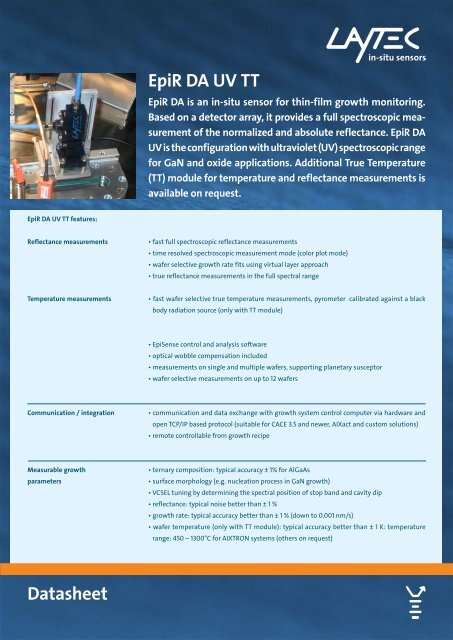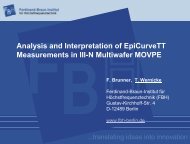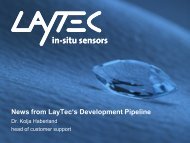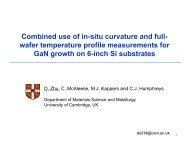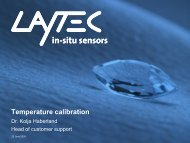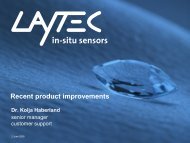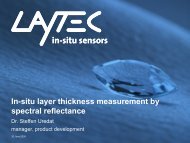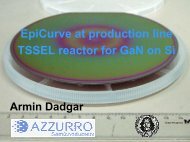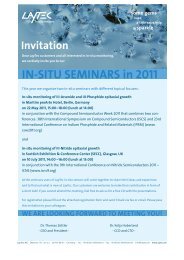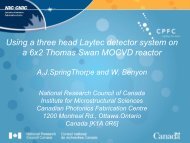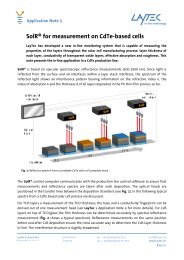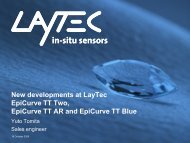EpiR DA UV TT Datasheet - Laytec
EpiR DA UV TT Datasheet - Laytec
EpiR DA UV TT Datasheet - Laytec
Create successful ePaper yourself
Turn your PDF publications into a flip-book with our unique Google optimized e-Paper software.
<strong>EpiR</strong> <strong>DA</strong> <strong>UV</strong> <strong>TT</strong> features:<br />
Reflectance measurements<br />
Temperature measurements<br />
Communication / integration<br />
Measurable growth<br />
parameters<br />
<strong>Datasheet</strong><br />
<strong>EpiR</strong> <strong>DA</strong> <strong>UV</strong> <strong>TT</strong><br />
<strong>EpiR</strong> <strong>DA</strong> is an in-situ sensor for thin-film growth monitoring.<br />
Based on a detector array, it provides a full spectroscopic measurement<br />
of the normalized and absolute reflectance. <strong>EpiR</strong> <strong>DA</strong><br />
<strong>UV</strong> is the configuration with ultraviolet (<strong>UV</strong>) spectroscopic range<br />
for GaN and oxide applications. Additional True Temperature<br />
(<strong>TT</strong>) module for temperature and reflectance measurements is<br />
available on request.<br />
• fast full spectroscopic reflectance measurements<br />
• time resolved spectroscopic measurement mode (color plot mode)<br />
• wafer selective growth rate fits using virtual layer approach<br />
• true reflectance measurements in the full spectral range<br />
• fast wafer selective true temperature measurements, pyrometer calibrated against a black<br />
body radiation source (only with <strong>TT</strong> module)<br />
• EpiSense control and analysis software<br />
• optical wobble compensation included<br />
• measurements on single and multiple wafers, supporting planetary susceptor<br />
• wafer selective measurements on up to 12 wafers<br />
• communication and data exchange with growth system control computer via hardware and<br />
open TCP/IP based protocol (suitable for CACE 3.5 and newer, AIXact and custom solutions)<br />
• remote controllable from growth recipe<br />
• ternary composition: typical accuracy ± 1% for AlGaAs<br />
• surface morphology (e.g. nucleation process in GaN growth)<br />
• VCSEL tuning by determining the spectral position of stop band and cavity dip<br />
• reflectance: typical noise better than ± 1 %<br />
• growth rate: typical accuracy better than ± 1 % (down to 0.001 nm/s)<br />
• wafer temperature (only with <strong>TT</strong> module): typical accuracy better than ± 1 K: temperature<br />
range: 450 – 1300°C for AIXTRON systems (others on request)
<strong>EpiR</strong> <strong>DA</strong> <strong>UV</strong> (<strong>TT</strong>) standard package<br />
15 pin interface cable (5 m): trigger pulse<br />
optical<br />
head<br />
Optical head<br />
fibre optical cables (10 m)<br />
Electronic control unit<br />
(incl. diode array detector)<br />
Xenon light source unit<br />
growth system<br />
and growth computer<br />
(not delivered by LayTec)<br />
xenon light source unit<br />
25 pin Sub-D cable (2 m)<br />
light source: high pressure XBO lamp, 75 W<br />
- manufacturer guaranteed lifetime 400 h<br />
- typical life-time 700 h<br />
- warm-up time 45 min<br />
spectroscopic range of detector array wavelength: 300 nm ... 770 nm*<br />
spectroscopic resolution ± 5 nm<br />
integration time 50...1000 ms<br />
number of pixels 1024<br />
pyrometry wavelength and bandwidth 980 nm ± 12.5 nm (only with <strong>TT</strong> module)<br />
typical time resolution 100–300 ms/spectrum incl. data transfer<br />
data repetition rate:<br />
growth<br />
control computer<br />
electronic control unit<br />
LAN connection (optional)<br />
(depends on integration time)<br />
- in single wafer reactor up to 1 data set every 4 revolutions of the wafer<br />
- in multiple wafer reactor up to 1 data set every 4 revolutions of the susceptor**<br />
typical noise level < 1%<br />
The control unit is a standard 19” case that can be easily mounted into existing 19” racks. It<br />
is connected with the optical head, the control computer, the xenon light source unit and the<br />
growth system as shown in the drawing above.<br />
The xenon lamp is incorporated in the second standard 19” case connected with the optical head<br />
(for incoming light) and the electronic control unit as shown in the drawing above.<br />
Control computer • 19” rack mount control computer<br />
• CPU: Pentium Core 2 Duo, min 1.66 GHz, RAM min. 1 GB<br />
• HDD min. 160 GB, RAID 1<br />
• DVD-writer, card reader, mouse, keyboard<br />
• 100 Mbit/s LAN interface or better<br />
• operating system: Windows XP pro MUI (multi language version)<br />
• 19” TFT flat screen (monitor resolution of 1280 x 1024 or higher)<br />
SH 100-200<br />
electrical cable (2 m)<br />
control computer<br />
Miscellaneous items • reactor specific mounting and adjustment unit<br />
• manual and software CD<br />
• additional USB license dongle for growth rate analysis and growth rate fit on office computer<br />
• Al-Si eutectic wafer for temperature calibration (special coated 2”, 3” or 4” wafer)<br />
*for applications with small aperture view ports or windows with limited transparancy the short wavelength limit might be shifted to longer wavelength<br />
** each wafer must be visible through the viewport for at least 95 ms (i.e. max. rotation frequency of e.g. 100 rpm in 6x2” configutration)<br />
2
Communication with<br />
growth system<br />
<strong>EpiR</strong> <strong>DA</strong> <strong>UV</strong> (<strong>TT</strong>) standard package<br />
Cables • 2 optical fibres (optical head electronic unit / optical head xenon light source): 10 m,<br />
core diameter 600 μm, special <strong>UV</strong>-transparent material; minimum bending radius 36 cm<br />
• SH 100-200 electrical cable (2 m, electronic unit computer)<br />
• 25 pin Sub-D cable (electronic unit xenon light source): 2 m, parallel port stepper motor<br />
cable<br />
• optionally, a KVM extension set (cable or ethernet based extender) is available<br />
• 15 pin interface cable (5 m, electronic unit growth system): transfers the trigger and marker<br />
signals and exports analog voltages proportional to the measured temperature and reflectance<br />
(see “communication with growth system” below)<br />
• multi-plug and power cables<br />
The electronic control unit is connected to the growth system by a 15 pin interface cable (trigger<br />
pulse is mandatory). Optional LAN connection to growth control computer is available.<br />
Please note: for the LAN connection a special software interface on the growth system computer<br />
is necessary. The interface should be arranged by the customer with the manufacturer<br />
of the growth system.<br />
Communication features 15 pin interface cable LAN connection<br />
rotation synchronous trigger pulse (once per susceptor<br />
revolution) from growth system*<br />
2 digital signals to growth system indicating<br />
heartbeat and busy/error status<br />
start/stop signal from growth system for remote<br />
control from the recipe<br />
reflectance calibration signal from growth system<br />
to indicate substrate reflectance<br />
up to 3 marker signals to indicate different<br />
growth steps and for data synchronization with<br />
the growth recipe<br />
process temperature from thermocouple or Eurotherm<br />
for advanced logging and calibration purpose<br />
pyrometer temperature to growth system for<br />
export of measured temperature (uncorrected or<br />
corrected)<br />
reflectance signal to growth system for export of<br />
the measured reflectance<br />
5V <strong>TT</strong>L, open<br />
collector signal<br />
5V <strong>TT</strong>L, open<br />
collector signal<br />
5V <strong>TT</strong>L or open<br />
collector signal<br />
5V <strong>TT</strong>L or open<br />
collector signal<br />
5V <strong>TT</strong>L or open<br />
collector signal<br />
analog voltage<br />
(0-10 V)<br />
analog voltage**<br />
(0-10 V)<br />
analog voltage**<br />
(0-10 V)<br />
Sizes and weights of the parts Parts Size X x Y x Z mm Weight, kg<br />
optical head 50 x 100 x 150 0.2<br />
control unit (19” rack 4 HE, 84 TE) 450 x 300 x 180 8.0<br />
19” rack for XBO lamp and power supply 450 x 300 x 180 8.0<br />
rack mount control computer (4 HE) 450 x 600 x 180 17.0<br />
19” LCD display 410 x 20 x 420 5.5<br />
mounting and adjustment unit reactor specific 0.2<br />
* this line is mandatory for multiple wafer systems and strongly recommended for motor driven single-wafer systems<br />
** in multi-wafer systems only averaged data or data from one specified wafer can be transferred<br />
–<br />
–<br />
via TCP/IP<br />
via TCP/IP<br />
via TCP/IP<br />
via TCP/IP<br />
via TCP/IP<br />
(all wafers individually)<br />
via TCP/IP<br />
(all wafers individually)<br />
3
<strong>EpiR</strong> <strong>DA</strong> <strong>UV</strong> (<strong>TT</strong>) requirements<br />
Requirements to the<br />
growth system<br />
Operating conditions<br />
Electrical connections /<br />
power consumption<br />
• standard normal-incidence optical view port, customized solutions with two optical heads<br />
for other angles of incidence on request<br />
• optical access to the sample:<br />
- AIX Planetary® G3, G4: 6 mm hole in reactor ceiling<br />
- AIX 200, AIX 200/4: 6 mm hole in liner tube<br />
- AIXTRON CCS®: standard viewport equipped with quartz window<br />
- MBE: heated viewport, no shutters in path of light<br />
• purged or heated window highly recommended to avoid window coating<br />
• for multiple wafer systems: rotation synchronous reset or home pulse from rotation axis,<br />
one pulse per revolution (5V <strong>TT</strong>L, open collector or relay contact)<br />
• max. rotation frequency depending on reactor geometry (e.g. ≤ 100 rpm for 6x2”, wafer<br />
must be visible for at least 95 ms)<br />
• optional for remote control: hardware and LAN connection to MOCVD system PC (to be<br />
arranged with growth system manufacturer)<br />
• feed-throughs for two optical fibers (feed-through plate for KF40 is recommended) if optical head<br />
is installed in the glove box<br />
Component Allowed temperature range<br />
operation storage<br />
optical head 10°C – 40°C 10°C – 60°C<br />
electronic control unit 10°C – 35°C 10°C – 60°C<br />
control computer 10°C – 35°C 10°C – 60°C<br />
• vibrations of optical head have to be avoided during the measurement<br />
• optical head is fragile, avoid shock-treatment<br />
• warm-up time: 45 min<br />
• the main connection (100-240 V) including extension cables to the control unit has to be<br />
provided by the customer<br />
• input voltage: 100 / 240 V auto detect<br />
• the power supply must be equipped with grounding wire<br />
• power consumption (typical values for 230 V operation):<br />
Component current / A typical power / W max. power / W<br />
control computer 3.5 134 max. 500<br />
monitor 1.5 26 40<br />
XBO lamp rack 0.6 138 138<br />
control unit rack 0.4 20 69<br />
total 318 747<br />
Availability <strong>EpiR</strong> <strong>DA</strong> <strong>TT</strong> is available with two different spectral ranges for <strong>UV</strong> (GaN, oxides) and IR (InP, GaAs)<br />
applications (see datasheet for <strong>EpiR</strong> <strong>DA</strong> IR <strong>TT</strong>). <strong>EpiR</strong> <strong>DA</strong> <strong>UV</strong> <strong>TT</strong> can be adapted to virtually any<br />
growth system. We have special mounts for AIXTRON single wafer and Planetary® systems (AIX<br />
200, AIX 200/4, AIX 2400 G3, AIX 2600 G3, AIX 2800 G4 except 24x2” and other multi-wafer per<br />
satellite configurations without a wafer in the center), AIXTRON Close Coupled Showerhead®<br />
(CCS) reactors (3x2”, 6x2”, 19x2”, CRIUS), for many MBE systems by Riber, Veeco / Applied Epi, VG<br />
and various custom built systems.<br />
Specifications are subject to further technical development and may differ from those given in the datasheet.<br />
For further information please contact:<br />
LayTec AG · Seesener Str. 10–13 · 10709 Berlin · Germany<br />
Tel.: + 49 (0)30 ·39 800 80-0 · Fax: + 49 (0)30 ·39 800 80-80<br />
www.laytec.de · info@laytec.de<br />
Version 5, March 2011


